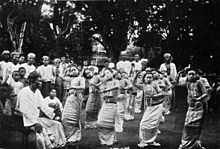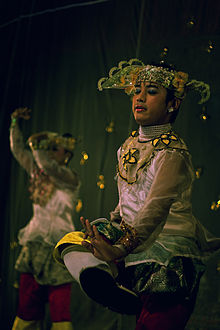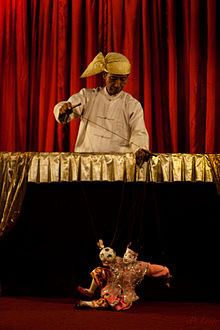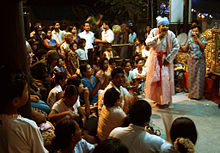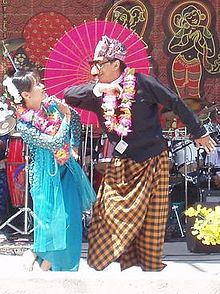- Burmese dance
-
Dance in Burma (now known as Myanmar by the government there) can be divided into dramatic, folk and village, and nat dances, each having distinct characteristics. Although Burmese dance has been influenced by the dance traditions of its neighbors, in particular Thailand, it retains unique qualities that distinguish it from other regional styles, including angular, fast-paced and energetic movements and emphasis on pose, not movement.[1]
Contents
History
The origins of Burmese Dance are traced to the Pyu, Halin, and Mon cultures in the central and lower Irrawaddy regions from at least two centuries before the Christian era.[2] Archaeological evidence shows Indian influences already in this.[3][4] There were also influences from Thai and Khmer cultures during the many invasions and counter-invasions that occurred over the next two millennia.[4] There was a particularly well documented infusion of dance forms, such as the Yama Zatdaw (the Burmese version of the Ramayana) in 1767, when the Burmese sacked Ayutthaya (ယိုးဒယား) and expropriated a large component of the Thai court.[4] Nonetheless, some of the surviving forms (including the belu, nat gadaw and zawgyi dances) honour folklore characters that are quintessentially Burmese, some of these from pre-Buddhist times. There is also a close relationship between the classical Burmese marionette and human dance art forms, with the former obviously imitating human dance, but also with human dance imitating the movements of the marionette.
After independence from Britain in 1948, there was a period of strong Burmese cultural nationalism that resulted in the establishment of the State School of Music in Mandalay in 1953. A well-known dancer of the day, Oba Thaung, is credited with codifying the nearly completely undocumented Burmese dance repertory. Her syllabus at the school was condensed into five dance courses intended as a five-year term of study. Each of the five courses is broken into dance sequences comprising a total of 125 stages, with each stage being precisely ten minutes long.[3]
Bagan dance
This dance originates from the time of the Pyu kingdoms (5th-10th century). A small number of relatively crude musical instruments were used and the dance style is slow and sedate. The costumes of dancers, as depicted in wall paintings, were scanty and revealing.
Bilu dance
The bilus (demons or ogres) are ancient characters, thought to originate from a legendary race that roamed India and Burma circa 2000 BC. Buddhist literature describes them as primitive and feared by other races.
In literature, the Belus are described as having transmogrifying powers—an ability to take on different physical appearances. There are 24 different classical demon forms, each with its own name and role in stories and plays. One of the best known is Dasagiri, a demon in the Indian Ramayana epic.
In any of his forms, the Belus embodies the Devil. He is terrifying, overbearing and diabolical by nature. But he has a gentle side also. In a typical dance, Dasa-Giri often offers a bouquet of flowers to a dainty damsel. The demure lady is unable to overlook the beastly side and declines his darling present. The demon then expresses his dejection at the refusal.
Kinnara and kinnari dances
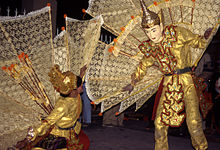 Shan kinnara and kinnari dance
Shan kinnara and kinnari dance
There are many references in the Pali and Sanskrit literature to the mythical birds with human head and torso, Kinnara (male) and Kinnari (female). According to the literature, the birds originated in prehistoric India. They appear in some of the discourses of the Lord Buddha himself.
In Burma, images of the Bird's dancing styles are found painted and carved on the walls at Bagan and (even earlier) from the Pyu kingdoms.
The songs and dances describe the Bird's happy re-union after a separation of 700 nights due to a heavy rainstorm and floods. The dance is a popular emblem of true love and has an ancient history that is kept alive by the Burma dance troupes.
The dancers are attired with flapping wings at their wrists, in contrast to wings at their armpits, as is characteristic of Thailand and other Asian countries. The dance of bird-like movements is very supple and fine, and intricately coordinated with the accompanying music.
Mount Popa's guardian spirits dance
According to Burmese folklore (but probably based on quasi-historical facts), Me Wunna, a beautiful blonde princess was a sister of the king of Thaton in lower Burma. Estranged from her brother, she refused betrothal to a royal descendent and lived in exile and alone in the forests of Mount Popa. As a devout Buddhist she abstained from eating meat and lived solely on flowers and fruits. She generally wore the mask of a demon to frighten away foes and friends alike. Thus she was reputed to be a flower-eating demon.
Later she fell in love with a royal dispatcher of fantastic physique, and begot two able sons with him. Unfortunately, her spouse was then executed for being derelict in fetching flowers from the mount. As a result, he became a nat (spirit).
Me Wunna's two sons, when they grew up, became distinguished heroes in the Royal Army. Unfortunately they fell victim to an intrigue, were executed for pretense, and became transformed into the two famous Spirits, the "Brother Nats" of Taungbyone.
However that was not the end of it. The bad tidings of her sons’ untimely deaths caused Me Wunna to die of heartbreak. So she became a nat as well and became duly enshrined at Mt. Popa, where she became "Super-Exalted" to supreme power in the Realm of the Nats.
The dancer, clad traditionally in regal apparel of green color, impersonates the Spirit. On her head is perched the mask of a demon. In her hands, she holds two quills of a peacock's tail, the symbol of the sun, in order to banish Darkness (the evil element). She dances as an apparition with grace and subtlety.
Nat dance
In Burma, it is traditional to make an offering of a green coconut, three hands of bananas, and a few other accessories, to the Guardian Spirit of Land (a nat) prior to an important event such as an inauguration. This appeasement of the Spirit is usually done by a professional Spirit Medium (Nakadaw).
The dancer is often attired in red silk, including a red headband and, around the chest, and a tightly knotted red scarf. With the offerings on a tray, she or he dances in propitiation and repeats the sequence three times. As Medium dances she sings ritual songs to the 37 National Nats (Spirits) and the Local Nat.
At the onset, the dance is delicate and the music legato. After a verbal injunction, the dancer quickens to the rising intensity of the music. As the Medium enjoins the Spirits, the movements and the music reach a frenzied crescendo.
Oil lamp dance
In the oil lamp dance (ဆီမီးကွက်အက), the traditional oil lamp offered to the Lord Buddha is a lighted wick of cotton soaked in an oil-filled earthenware saucer is the centerpiece of the dance. A lighted candle now usually substitutes in its place. The Rakhine people of western Burma incorporate the oil lamp dance in many of their traditional dances, mostly devotional, to the Buddha.
The performer's hands are always upturned (to retain the oil). Elders who remember performing with traditional lamps say that the secret is to not let the lamp drop while, at the same time, conveying particular expressions with various attitudes of the hands and legs. "It is almost an ordeal", they added.
Ramayana dances
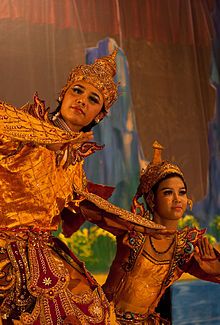 Rama (Yama) and Sita (Me Thida) in a reenactment of the Yama Zatdaw
Rama (Yama) and Sita (Me Thida) in a reenactment of the Yama Zatdaw
In 1767, King Hsinbyushin of the Konbaung dynasty brought back Siamese captives to the Innwa (Ava), the kingdom's capital. Among the captives were Siamese court dancers who performed the Ramayana (Yama Zatdaw) wearing masks.
In this epic, Rama is the hero and chief character, Sita is the heroine, and Dasa-Giri is the villain demon. In a typical segment, Rama is enticed away by the Golden Deer, who is a transmogrified form of the demon sister of Dathagiri (Ravana). Dathagiri himself is metamorphed as a Hermit. Rama is then seen gravely following the tracks of the alluring Deer. The Deer leaves subtle hints as a trail.
U Min Gyaw dance
U Min Gyaw, alias Pakhan Kyaw, is a well-known Burmese nat (spirit). There are a few different versions of his biography. One is that, being an adept horseman and son of a trusted royal guardian; he was knighted and given the Countship of the country town of Pakhan in central Burma. However, once in office he indulged himself in drinking, gambling (especially cock fighting), and in womanizing. He eventually had the audacity to dethrone and execute the king and others, including two young brothers, sons of a nobleman. These two brothers became famous nats and went on to long careers of mischief. However, in their very first act, the two brothers used their new powers to pay back the Count in his own coin, causing the Count's murder and his return as the Nat U Min Gyaw.
When he takes on his human form, U Mingyaw takes relish in drinking toddy, the sap of the palmyra tree (aka the "toddy palm"). His favorite hors d'œuvre, to go along with sap is fried chicken or fowl. Therefore the most effective propitiation is thought to be a pot of toddy and a fried fowl. Petitioners believe that U Min Gyaw will fulfill any wish that is made to him during his trance, although he usually expects a commission.
In a typical performance, the Medium appeals to U Min Gyaw by presenting him with a bottle of liquor in one hand and a fried fowl in the other. The dancer copies the drunken style of the Spirit.
U Shwe Yoe and Daw Moe dance
U Shwe Yoe and Daw Moe dance in Los Angeles, 2007
Rather than a classic, this dance is an example of contemporary Burmese folk art. The dance has appeared out of the custom of entertaining the crowd, especially volunteers taking part in Flag Days or at community charitable activities. Its purpose is to inspire people to donate and to do meritorious deeds for the betterment of next lives.
The names U Shwe Yoe and Daw Moe are fictitious (not part of any classic text) and chosen for their rhyming effect. There is no established melody for the dance. Instead the orchestra improvises any lively tune, or recorded music is sometimes used. Enthusiastic citizens with no formal dance training often perform. The roles are one Old Bachelor (U Shwe Yoe) and one Spinster (Daw Moe), the latter played by either a male or female dancer. The choreography is spontaneous and designed to give the audience the best medicine.
The costumes are bizarre and flamboyant, with the indispensable elements of U Shwe Yoe's (independently animated) moustache and a twirling Pathein parasol. In a jocular manner, he emotes his love and makes a pass at Daw Moe, while she responds evasively and artfully. The audience, often mostly children and old folk, clap loudly and encourage Shwe Yoe in his persistence.[3]
Zat pwe duet dance
All-night performances, which combine melodrama, slapstick, traditional dance, and even pop music are called "zat pwe" in Burma. These seasonal events are staged in enclosed temporary bamboo theaters and are typically part of annual fund raising activities at pagoda festivals. The performers are traveling troupes, usually several dozen professional male and female dancers, musicians, comedians, and actors. These troupes travel widely throughout the country. The Duet Dance, a standard part of the Zat Pwe, typically starts near 2- or 3-AM, and has a duration of about two hours.
Generally the lead actors dance with the lead actresses. The male dancers make a display, often with highly athletic and inventive elements. The male and female dancers sing in duet and exchange lover's vows.
There is often a competitive aspect to see who in the troupe can win the favor of the loudest cheers. During all of this, the orchestra must synchronize to the action occurring on the stage. When done with excellence, this dance can create national fame for the troupe.
Zawgyi dance
Zawgyi is a Burmese folk character adept in the art of alchemy. He is said to have gained his supernatural skills through occult means. He inhabits thick forests near the Himalaya where he forages herbs for magical purposes. After searching for many years he obtained the Philosopher's stone and thereby gained Zawgyihood. Sometimes, with a touch of his magic wand he brings to life "illusory females" from trees bearing female-shaped fruits in order fulfill his carnal wishes.
The dance illustrates Zawgyi going about the forest, prancing with his wand, pulverizing herbs and gamboling in jubilation after acquiring the Stone.
References
- ^ Marshall Cavendish Publishing, ed (2007). World and Its Peoples: Eastern and Southern Asia. Marshall Cavendish. pp. 630–640. ISBN 9780761476313.
- ^ Oba Thaung: Who Systematized Myanma Dance, Zaw Pale and Khin Win New, (translated to English by Than Tun (1995)
- ^ a b c Program notes of the Mintha Theater in Mandalay.
- ^ a b c D.G.E. Hall, Hutcheson and Co., London 1950
External links
Architecture · Visual art · Cinema · Clothing and dress · Cuisine · Dance · Folklore · Literature · Marionette · Media · Music · Public holidays · ReligionDance in Asia Sovereign
states- Afghanistan
- Armenia
- Azerbaijan
- Bahrain
- Bangladesh
- Bhutan
- Brunei
- Burma (Myanmar)
- Cambodia
- People's Republic of China
- Cyprus
- East Timor (Timor-Leste)
- Egypt
- Georgia
- India
- Indonesia
- Iran
- Iraq
- Israel
- Japan
- Jordan
- Kazakhstan
- North Korea
- South Korea
- Kuwait
- Kyrgyzstan
- Laos
- Lebanon
- Malaysia
- Maldives
- Mongolia
- Nepal
- Oman
- Pakistan
- Philippines
- Qatar
- Russia
- Saudi Arabia
- Singapore
- Sri Lanka
- Syria
- Tajikistan
- Thailand
- Turkey
- Turkmenistan
- United Arab Emirates
- Uzbekistan
- Vietnam
- Yemen
States with limited
recognition- Abkhazia
- Nagorno-Karabakh
- Northern Cyprus
- Palestine
- Republic of China (Taiwan)
- South Ossetia
Dependencies and
other territories- Christmas Island
- Cocos (Keeling) Islands
- Hong Kong
- Macau
Categories:- Burmese culture
- Asian dances
- Dance by ethnicity or region
Wikimedia Foundation. 2010.

